In honor of Earth Day we’ve been invited by Jan at Thanks For Today to participate in the Garden Bloggers’ Sustainable Living Project. Jan has asked that gardeners highlight what it is they’re doing to help, rather than hinder, Nature.
There are numerous definitions of sustainable living and gardening, but in general sustainability hinges on the principle that in the time we are here, we strive to meet our needs, but without preventing others from meeting their own needs in the future, be they plant, or animal, or insect. In short, conservation of resources are at sustainability’s core.
Gardens do not exist in a vacuum. Every garden, large or small, is an ecosystem. Whether or not it’s a functioning and thriving ecosystem wholly depends on the methods deployed by the individual cultivating the land.
It’s fair to presume that all gardens impact the environment. The key is to maximize the positive impacts, and minimize the negative, and to mitigate any negative impacts as much as we can. To do that effectively we as gardeners need to consider that our garden is more than mere plants. It’s an oversimplification, but at a minimum the core elements of our garden are water, air, soil, plants, animals, and insects, and each deserves our consideration when working within the landscape.
Water Quality and Conservation
Sustainability in the garden often evokes images of a closed garden system that provides for all of its own needs without the importation of any external resources. However, in reality most gardens, even the most sustainable ones, will at a minimum require the use of at least some water.
We use private well water for irrigation, but that doesn’t mean we have an unlimited supply. We’re situated over an aquifer recharge area, meaning that the water that falls on our land, and runs off our slopes, perking through our soils, eventually goes to sustain others in the community outside of Curbstone Valley. To conserve water we avoid the use of wasteful overhead watering methods, and instead have installed drip irrigation throughout the orchard. The drip irrigation for the vegetable gardens hopefully will be completed by later this spring.
To reduce our long-term watering needs, we also are planting and propagating water-wise native plants that are adapted to growing in our region, and don’t demand excess irrigation.
This has turned out to be easier than we expected, as we’ve discovered a host of native plants on the property that are adapted to growing here.
At the end of last year we invested in a weather station. It may seem like an extravagance, or a fun toy for weather geeks, but we’re also hoping it will aid us with water conservation.
Through the use of integrated soil moisture sensors, we hope to be able to have the weather station control the irrigation for our orchard and gardens in the near future. This way, rather than water on predetermined days of the week, whether it’s needed or not, we’ll only be watering when the soil and plants really need it.
Preserving Air Quality
I remember once being shocked that in America some of the worst air quality is found in the areas surrounding farmland. I’d grown up in England, in a time, and place, where mammoth scale farming simply didn’t exist, and filthy air was confined to the city. Large scale farms in the United States are notorious for contributing to poor air quality. Ploughing and tilling release particulates into the air, along with thousands of pounds of pesticides, herbicides and synthetic fertilizers that significantly, adversely, and invisibly contribute to high levels of air pollution.
That said, gardeners can also impact air quality, in all of the same ways, albeit on a smaller scale. Our gardens here are tiny compared to the average commercial farm, but even so, the use of pesticides, herbicides, and poor soil preparation methods would still impact our regional air quality, and pollute our waterways. We don’t use synthetic pesticides, fungicides, or herbicides, both for our benefit, and for the other residents of the farm.
As individuals we can also affect air quality, even beyond the farm, by where we choose to source our food. Simply eating foods that are in season, and available either in our own gardens, or from local area farms, significantly decreases how much fuel it requires to get our food to the table.
Trees of course are vital to maintaining, and improving air quality. We’re fortunate to be surrounded by trees. Rather than clear the land for our own purposes, we’ve chosen to only cultivate a small piece of the property. We are also striving to improve conditions for some of our native trees in the surrounding woodland, especially in areas that have become overgrown around the native Oaks and Pacific Madrones, significantly jeopardizing their health.
By improving their growing conditions, and decreasing overcrowding, the remaining trees should be healthier and hopefully will continue to grow here for many years to come.
Essential Soils
Our soils are poor. There’s no denying it. Our most fertile soils are on the valley floor, but the slopes and plateaus are comprised of relatively nutrient devoid sandy soil. For much of the property that’s fine, it’s what our natives are adapted to growing in. They demand excellent drainage, and would resent rich soil. Orchards and vegetable gardens however do not grow well in sand.
For those areas, we compost our kitchen scraps, at least those that don’t go through the chickens and turkeys first.
We amend the compost with nitrogen rich poultry manures, and now are incorporating the by-products of a nearby stable to help improve soil quality, texture, fertility and moisture retention.
Most of the vegetables are grown in raised beds so we have the most control over soil composition there.
The beds also prevent erosion and run-off compared to planting vegetables directly on our slopes. The orchard soil is largely left alone, with the exception of mulching directly around the fruit trees. As we want native annuals and perennials to in fill the orchard between the trees, rather than conventional cover crops, the soil there needs to remain relatively lean.
Another issue with our loose soils, especially with heavy winter rains, is that they are prone to erosion.
This winter it was a significant problem. Not just because of the physical risks associated with collapsing and eroding soils, but because of the impact that erosion has on the creeks. Mitigation of erosion and runoff is essential to creek health, and during some of our severe storms this winter it was disheartening to see the creeks on the property turn brown due to all of the soil particulates in the water that were washed down the mountains.
Soil erosion not only increases the turbidity of the water, but fertilizer runoff alters the nutrient cycling within creeks and oceans, and can lead to unfavorable growth of harmful organisms such as bacteria and algae.
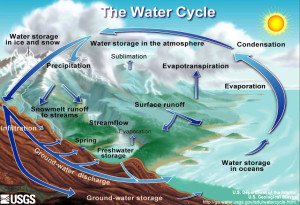
The water cycle illustrates how gardeners and farmers can impact the environment far beyond their property line (Image Source: USGS - Public Domain)
Although we don’t use chemical fertilizers, we also don’t use organic fertilizer late in the growing season to decrease excess nutrient runoff from our slopes, preferring to use compost instead. This year, to limit the soils being washed directly into the creeks from this property, we’re consulting with soils engineers and contractors to help us install a retaining wall along the base of the orchard slope, which currently seems to be the most prone to weathering and erosion. It’s not much in the grand scheme of the entire watershed, but we feel is necessary nonetheless.
Picking Plants
We can’t have a garden without plants. Plant selection here is critical to minimizing the need for water and fertilizer inputs. Fussy plants, grown out of place, in climates or conditions they’re not ideally suited to, frequently demand extra care and resources. We intentionally select plants that like to grow here. Whether it’s choosing pest and disease resistant fruit cultivars that perform the best in our climate, or carefully selecting or propagating natives that are already here, and thrive without supplemental irrigation.
As plant choices strongly impact water use, we’ve chosen not to cultivate lawns on the property. Even organic lawns waste water to maintain their lush color, and require too much wasted energy to mow.
Most importantly lawns lack the diversity necessary to sustain the wild creatures, including the pollinators on the farm.
Resident Wildlife
If you’ve read much of this blog, you know we have wildlife…lots and lots of wildlife, and that’s so much of what makes Curbstone Valley special to us.
Leaving the majority of the land here as it was, removing invasive plants, and slowly restoring and enhancing the natives that should be here, we hope we’re contributing to sustaining the wildlife populations that live here, both now, and in the future.
Although we did fence the small orchard and garden area, we’ve ensured that no fences block the ability of wildlife to travel through or around the property. The deer, coyotes, bobcats, mountain lions, and other wildlife are free to walk all around the orchard and garden unencumbered, and invariably around Frodo’s pen too.
Although fences help us to protect our plantings, fences are also potentially harmful to the wildlife resident on the farm. So much land is fractured and fragmented already in urban areas, that many larger wild species simply can’t survive where they once did. We’ve chosen to balance the needs of our own animals, and plants, with those that were here long before us. Honestly, having owned a number of fences in the past, we’d rather look outside our windows and see this, than a six foot fence…
The advantage of not encumbering the movements of local wildlife, is that it helps to sustain a balance between predators, and pests. Even fencing the small area of the orchard has tipped a balance. Without the fence, there would be no fruit, but with the fence we have increased populations of voles and gophers as some of their key predators can no longer reach them.
This means the Bobcats and Coyotes that would have helped to keep the populations in check, now have to forage for food elsewhere on the property, and we are left cursing at the gopher holes, and missing pea plants.
To mitigate this we’re hoping that by encouraging owls on the property that they can help to fill some of the void.
Important Insects
As at least part of the point of Curbstone Valley is to grow food, we’d grow nothing without the hoards of insects that live here, and not just the pollinators. Even the pests are important! Really! Remember? Our goal is a thriving eco-SYSTEM.
For example, without aphids, our Syrphid fly larvae miss out on an important and nourishing meal, and as adults the Syrphid flies are important crop pollinators.
The most obvious beneficial insects on the farm, but by no means the only ones, are of course the bees, both the European honeybees and our native bees. It’s gratifying to see the numerous bumble bees zipping around the wildflowers in spring.
The green sweat bees lurking among the sunflowers in late summer…
…and the honeybees covered in pollen in the vegetable garden throughout the growing season.
These alone are tens of thousands of reasons for us to be mindful of the quality of our water, air, and soil, and to ensure we have a diversity of plants on the farm.
The butterflies are also important pollinators, and by providing host plants for them, we ensure we’ll have future generations visiting our gardens.

It's now spring, and there are numerous Variable Checkerspots in chrysalis form waiting to emerge as butterflies
So in short, we’re not perfect, and we’re not doing any one revolutionary thing here at Curbstone Valley. We are simply doing our best to maintain a healthy and sustainable environment for all of the inhabitants of the farm. We have grown attached to the land here, and know this is a very special place, not just on Earth Day, but every day.


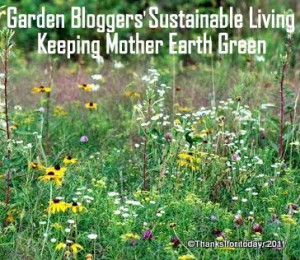


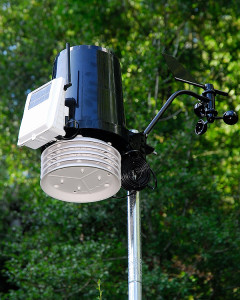
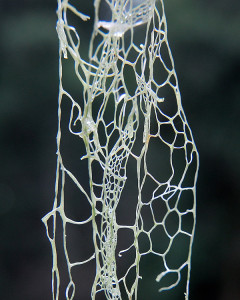
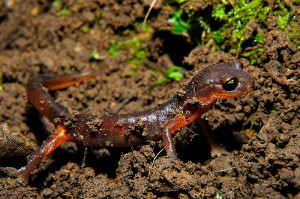
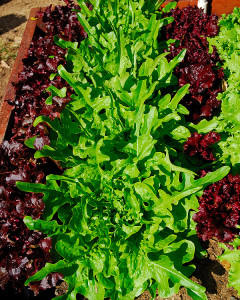
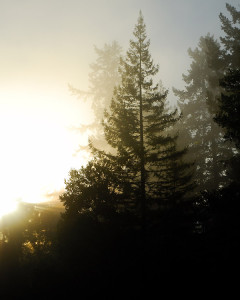

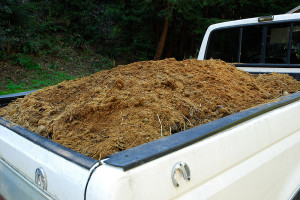

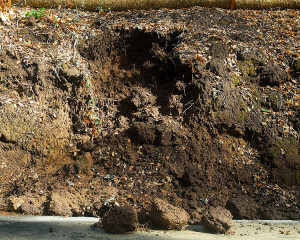
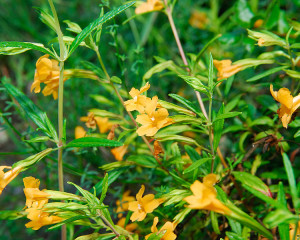
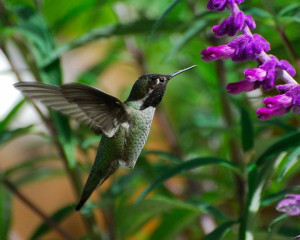
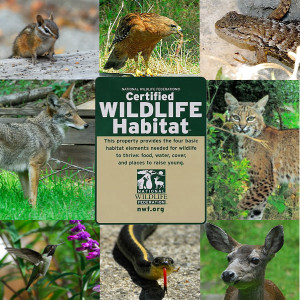
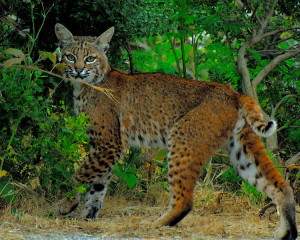
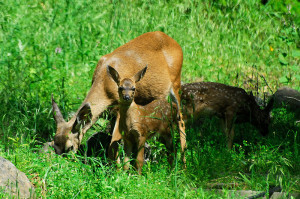
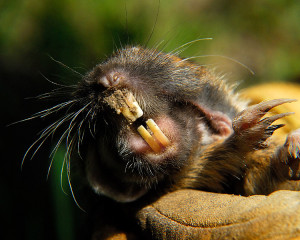
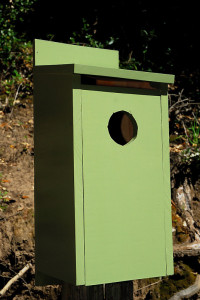


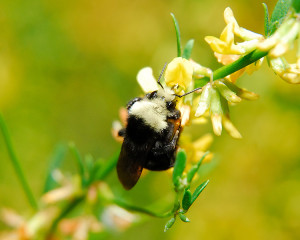
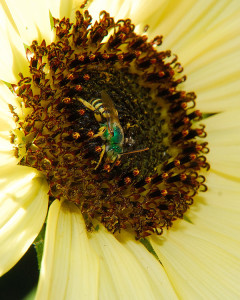
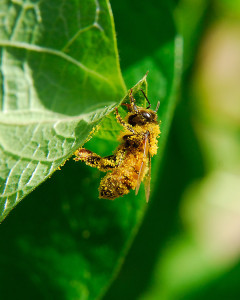
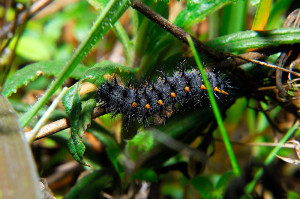







Wow, what a post! You hit on every “easy” sustainable garden topic, but also some that I never would have thought of. The effect of fencing just a portion of your property? The importance of non-bee pollinators and how to ensure they’re around?
Just a fantastic post! =D
I’m not sure that before living here I would have thought much about the fences, or the alternative pollinators either. We’ve learned a lot living here, and getting to know the land.
Last time we drove to Cape Town, it was especially windy and the dry ploughed fields raised walls of dust. Only as I read your post, do I realise we are breathing in the pesticide and herbicide and fertiliser.
Wonderful to have the option, and take it, of not having a perimeter fence.
I remember farmland as being something more idyllic than toxic. Now when I drive by a farmer ploughing, I have an urge to hold my breath 😉 You’re right about the fence. Here we have a choice, and in large part that is because of the topography of the land. The slopes in a way create something of a natural fence, enough to keep the chickens in, it’s just not exclusionary.
Excellent, excellent information! I like that you mention that even the ‘pests’ (aphids) can be beneficial in their own way. It’s all about balance, and Curbstone Valley sounds like a model for sustainable living to save the earth for our children and our children’s children…
I used to use insecticidal soaps with abandon in our last garden, smothering the aphids on the rose bushes. I’ve come to realize that even those aren’t selective, and by removing them some of our beneficial insects won’t find enough food to stay. I’m hoping that by striving to preserve a balance, and not interfering, that eventually the predators and pests will achieve their own balance.
Excellent article, lots of info here that I never thought about before. Thanks!
Really great post! I also hadn’t thought about fencing and how that can keep wildlife that travels the area out. Reading your post reminds me of more things that we can do around here as well as pointing out some of the things we are already doing. Yesterday I was noticing some type of tiny fly or bee on one of the flowers and realized it was probably some type of pollinator that I would never have paid attention to before. I really didn’t realize that insects other than bees and butterflies pollinated.
Many beetle species are also important pollinators, and many of our native plants used to depend on them for pollination before the European honeybees arrived. It is easy to only the see the bees, and miss all of the other important insects in the garden.
Clare, I am extremely impressed with your post…so much information, and you’re actually participating in all of these aspects of sustainability. You bring up many ways to positively impact our environment…some that are not typically thought of. Excellent post!
This may be a duplicate..computer issues. Regardless, I’m happy to leave a second comment since I was so impressed with this post! You highlight so many ideas to positively impact our environment…some that aren’t the norm. Really excellent post, Clare! And awesome that you’re doing so much to promote our earth and its natural systems.
I think it’s just how I hatched. I used to spend hours and hours as a child down by a local canal bank, watching the insects, the birds, and bunnies, and seeing how everything interacts. Here I still sometimes feel like that same 6 year-old, flipping over logs and rocks, and just appreciating what’s here. 😉
What an incredible post…you have a well thought out plan that anyone can take parts from and incorporate…I love the idea of the weather station helping to schedule watering…so often I see sprinklers on in the rain simply because they are on a timer…I think you hit every major point….my hat is off to you for doing all this and you have set a wonderful example for us all to follow
I was so excited when I found out that this weather station had soil moisture sensors, and an irrigation control interface. Once I learned that, it seemed like a no-brainer. We were replacing an old weather station that had expired, and this just seemed to make sense.
You are doing many sustainable things at Curbstone to do your part in keeping your footprint small. Yesterday, I participated as a MG in an Earth Day seminar, and we discussed many points of what you noted and all the good practices that Cornell is doing on their plantations as innovative practices. But most are just common sense and too bad many do not use common sense. As speakers, we explained IPM and good design.
That really is it Donna, so much of it is simply common sense. I see all of the terms like ‘organic’ and ‘locovore’ thrown around these days, but when I grew up that was called growing veggies in your own back yard. I’m sure most gardens were healthier then than they are now. I’d rather Nature finds a balance, than I try to force one. Besides, she’s much smarter than I am 😉
Clare, At Carolyn’s Shade Gardens, I follow all the same practices that you have written about so eloquently, but for an additional reason: it’s easier and cheaper. For example, I don’t plant plants that require any supplemental water once established so I don’t have to spend time watering or pay for the water. I use plenty of compost at planting so I never apply any fertilizers, organic or otherwise. I leave most leaves in my beds so I don’t spend time and money cleaning them out and mulching. In losing sight of sustainability, we have also made gardening a lot more expensive and labor intensive. Carolyn
Too true! I’ve seen gardeners spend small fortunes on fertilizers and pesticides all in a quest for their garden ideal. I’d rather spend the money on plants 😛
Great post! Because my vegetable garden abuts a natural waterway that reaches all the way to the Long Island Sound, I am keenly aware of how our simple practices on our own land can effect the world!
Thanks for stopping by Jayne. It is important as individual homeowners to have that kind of awareness. I think many still don’t think that curb signs stating “drains to creek” or “drains to ocean” applies to them. 🙁
I usually skip over extra long posts, but I left yours as a tab in my web browser so that I’d could take the time to read it later. Oh my! I respect the thought process behind your choices. You are very fortunate to have the land and time to do what you do. Thank you for sharing.
We are very fortunate to live here. The time though, not quite sure I have enough of that! The post did get a little long, sorry about that. Sort of developed a life of its own once I started typing 😉
You are a model of sustainable living! You have thought things through so carefully and are so mindful of all the earth’s plants and creatures. Very well done!
What a wonderful post…I am sharing this! For the past 4 years we have been becoming educated about sustainability in gardening. We are urban gardeners, living on what is literally a sand dune right next to the Los Angeles International Airport…so no streams, wildlife consists of squirrels, birds, and an occasional opossum. But we do our best, invite bees and hummingbirds, capture and reuse rainwater, leave leaves on the ground for ground cover, compost etc. The eco-system is so perfect if you have all the necessary ingredients. I remember being first introduced to this concept in “The Omnivore’s Dilemma.” Thanks for the post.
Another great post, Clare — packed with useful information and inspiration. Like Donna, I’m impressed and inspired by the kind of careful planning and big picture thinking that goes into your sustainability efforts.
What a fabulous post, inspirational and informative. I’d never thought about the role fences play in sustainablility, about their impact on wildlife. I also didn’t know about the way farmland creates poor air quality – I almost wish I was still ignorant 😉 I already follow most of the practices you describe – the ones that apply to a small village garden, anyway – but will bookmark this for future reference. Thank you!
Sorry about that 😉 Intensive farming related pollution was a surprise to me when I first learned about it some years ago. There actually was just an article on BBC News right after I wrote this post about the same subject, and its impacts on Europe’s wildlife.
Air pollution ‘damaging Europe’s wildlife havens’:
http://www.bbc.co.uk/news/science-environment-13094597
I enjoyed and learned a lot while reading what you do to “help” nature along. I never even considered the fencing aspect!
I am SO making an owl box with my scrap wood. Thanks for the instructions.
Thanks for stopping by my blog.
We’re hoping to make a few more owl boxes this year too. We still have some scrap wood left, and it felt like a great way to use it up! Would love to see your owl box when it’s done! 🙂
Clare, If I was prone to giving blog awards I would give you one! This post is a winner! It’s fantastically written, filled with excellent information and delightful photos. I feel the same about the aphids and leave them on the Golden Ragwort for predators to eat. It insures that the garden will have plenty of adult Syrphid Flies. gail
Thanks Gail 🙂 When I had a rose garden at the last house, I’d gasp when I’d see aphids all over the flower buds, and immediately reach for the garden hose. Now I don’t know what all the fuss was about. Then again, I don’t remember seeing any Syrphid flies there, but all my neighbors used lawn services, replete with oodles of chemical weed killers and fertilizers. Probably why I had so many aphids…
I did not know the Syrphid flies ate aphids in their early life — that explains why I always have so darned many by late summer. 😉
Wonderful post, Clare. Thank you for all you do on behalf of the Earth.
There are a couple of great YouTube videos of syrphid fly larvae chowing down on aphids. You can’t help but watch them, and find yourself cheering them on. I think I linked to one of the videos on our Syrphid fly post last year if you can’t find it. Makes for a fun, albeit slightly creepy video! 😉
Fabulous post and a really great project idea. I am going to post a link to this on my facebook page. I really like that photo of the trees by the way.
Thanks for sharing the post Sunny 🙂 The tree in foreground of the photo is a Coast Redwood, with a couple of Douglas Fir in the background. Part of the morning view here, and I love it. Glad you like it!
Beautiful post and a delight to read this rainy morning! We’re in the position of more or less starting from scratch right now and it sometimes feels like I can’t get sustainable practices implemented fast enough. I keep reminding myself we’ll get there… and that no matter how established a garden is, it’s still a work in progress.
As an aside, I’ve never seen lichen like that — wow!!!
Slowly and surely, you’ll get there. We still have lots more we’d like to do here. This year my goal is start blending our own seed starting and potting soil mixes so we can better control the contents and avoid using things like peat moss, and expanding our compost bin system too. With just two of us, it’s just not possible to implement everything at once. We’ll get there though, and so will you.
Isn’t that lace lichen fabulous? I found some this year when it was blown down during a storm from a Fir tree. Nature is truly remarkable.
Last weekend I spent outdoors in the garden. The farmer was ploughing the field about 150 yards from me and I ended up with a terrible sore throat for 3 days even though I didn’t have a cold. I’m wondering if the ploughing released something into the air as one of my neighbours suffered from the same condition.
I think the variety of wildlife is wonderful that you help to sustain at the farm. Your efforts in sustainability speak for themselves.
It could have just been physical irritation from the dust in the air, but it does make you wonder if it was more. I used to get sick often, and have my allergies flare up often when we lived near some farmland in the Central Valley. Every time I’d hear a crop duster fly over head, I’d run around the house and slam the windows shut…not that it probably helped much 🙁
This is a terrific post! You set an excellent example and are surely an inspiration to many. Your efforts have blessed yourselves as well as the wildlife of Curbstone Valley, and we in the blogosphere are blessed as well. Thank you!
Thank you Deb 🙂
Amazing post! I really admire the thought and care you’ve put into maintaining every aspect of your landscape, both the native and the cultivated. I totally agree with your take on perimeter fencing. In the 5 years we’ve lived on our 5-acre property, we’ve resisted the notion of fencing and have reaped the benefit of having wildlife traverse through, including coyotes, bobcats, grey foxes, and even the occasional mountain lion. Good for them, good for us! Again, kudos to you for your dedication to sustainable living!
I think we’re both fortunate with the lay of the land that fencing the perimeter is a choice, and one we can choose not to take. Even with all the Bobcat and Coyote woes in recent months, I wouldn’t have it any other way. Besides, we’ve become really good at building STRONG poultry housing, and Frodo seems to have adjusted to the local fauna too! 😉
What a fantastic post – It had everything – great pictures, fabulous educational value and truly inspirational.
Wonderful post. I applaud your taming of the invasive species and your general thoughtfulness on your property. It seems that your farm will be a much better place after your having been there. I was really surprised by the fact that fencing a very small area increased your vole/gopher population. A sign that everything we do does indeed have consequences.
The extent of your environmental knowledge and how in touch you are with your area is impressive Clare.
You surely live in a magical place… so beautiful! Your post is most excellent. If all of mankind could be so in tune with our stewardship of this beautiful earth.
I love the principles you are farming by. This is very much what I am trying to do in my own suburban garden, though on a much reduced scale. My blog is even called Loving Nature’s Garden. I guess we have a few things in common!
Claire, your entire post is so inspirational and I plan to read it over again & again. There is so much to take away from this–from your beautiful photos, to your thoroughly informative and educational prose. I found myself wanting to comment on just about everything. Many people with wells feel no need to conserve water, since they aren’t paying for it. My mom has a well & doesn’t think twice about running her sprinkling system on a regular basis. I didn’t know about all the pollution from farm byproducts, either. I did know about aphids & ever since I started planting milkweed, have had the yellow milkweed aphids. They don’t hurt anything though and if they provide a meal for another critter, then all the better! I love the photo of the bee covered with the squash pollen…it’s priceless! Thanks for mentioning the issue with fencing in smaller areas…I never thought about how that can have an impact on the critters. That must be why I’ve discovered more voles this year, inside my fence! Their predators cannot get to them. Hmm. Must re-think that one;-) Anyway, Curbstone Valley sure sounds awesome, in every way. I can understand, completely, why you want to take care of it;-) Thank you for joining in my project, and Happy Earth Day to you!